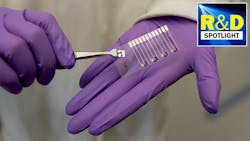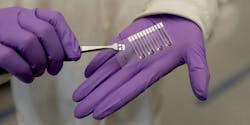R&D Spotlight: Inventing Wearable Sensors that Monitor Uric Acid in Sweat
Wearable biosensors are revolutionizing point-of-care diagnostics by offering real-time monitoring of physiological metrics and biomarkers. A team of researchers at Purdue University’s College of Engineering have invented non-invasive, wearable sensors that monitor levels of uric acid in human sweat.
Wenzhuo Wu, the Ravi and Eleanor Talwar Rising Star Associate Professor of Industrial Engineering, said that their creation allows for the non-invasive, repeated monitoring of uric acid (UA) levels in human sweat over long periods of time and could enable the unprecedented diagnosis, therapy and prognosis of several conditions, including anxiety and hypertension.
Dubbed EPICS (flexible piezo-electrocatalytic uric acid sensor), the sensors were created from zinc oxide, a nontoxic, biocompatible and electrochemically active material. The flexible UA sensors are based on ZnO nanorods and are designed to monitor uric acid in human sweat.
READ MORE: Five Biosensor Applications to Look Out For
“These patent-pending sensors, called EPICS, have higher sensitivity and better wearability and can be made from less expensive materials than traditional sensors that measure uric acid levels,” said Wu.
His team’s research has been published in Nano Energy.
Uric Acid Testing
Uric acid (UA) is a waste product that is formed when the body breaks down purines. It is mainly flushed out through the kidneys. UA, however, comes with both risk and redeeming characteristics. It is a normal part of metabolic breakdown of purine nucleotides and a normal component of urine. High rates of UA or build-up increases the risk of some health problems (such as gout and hypertension).
UA tests help medical practitioners diagnose the cause of recurrent kidney stones and monitor people with gout. UA also acts as an alarm that triggers inflammation as an immune response.
“Variation in UA concentration could indicate physiological diseases such as gout, hyperuricemia and hypertension, as well as psychological conditions such as anxiety and depression,” Wu said in a press note. “Recent studies report the physiological diseases associated with abnormal UA levels affect approximately 1%-4% of the world’s population and cost more than $20 billion in annual medical expenditures. The psychological conditions associated with abnormal UA levels impact 8.74% of the U.S. population and cost $33.7 billion in related medical expenses annually.”
Drawbacks of Typical UA Monitoring
Despite well-established clinical practices for measuring UA levels in blood (used for monitoring metabolism and nutrition), shortcomings remain.
“The intrusive nature of collecting blood and the delay between sample collection and analysis are major hindrances, especially to personalized remote treatments like flare-up prevention and just-in-time nutrition control,” Wu said. “Monitoring UA levels in sweat samples has the advantages of being non-invasive and offering real-time results.”
READ MORE: Wearable Sensors Detect Respiratory, Cardiac Symptoms
Still, current wearable sensors used to measure UA levels in sweat have limitations, including complicated fabrication processes, sophisticated instruments, expensive raw materials and unsatisfactory performance, note the researchers.
“The UA levels in the sweat of a healthy human are significantly lower than the UA levels in blood. This means sensors must have superior limits of detection,” Wu said. “Additionally, continuous monitoring requires intimate contact between the UA sensor and human skin, which imposes further requirements for the wearability of the sensors.”
Flexible UA Sensors
The researchers reported that advanced technologies such as wearable sensors can address these shortcomings.
The authors reported that their EPICS devices could achieve “a fourfold enhancement in the UA sensing performance with a small compressive strain (−0.9%), boosted by piezo-electrocatalysis during the electrochemical oxidation of UA on the surfaces of mechanically deformed ZnO nanorods.”
READ MORE: R&D Spotlight: Stretchable, Flexible Li-Ion Batteries are a Natural Fit for Wearables
The EPICS devices exhibited a superior sensitivity that outperformed all reported flexible electrochemical UA sensors, according to the researchers, who have tested EPICS at Purdue University’s Flex Lab since the summer of 2021.
“Our design allows the possibility of non-invasive monitoring of UA with a boosted performance by otherwise wasted mechanical energy, such as that from the human body,” noted the authors.
Sensor Innovation Patent Application
Wu and his team have applied for a patent to protect the intellectual property through the Purdue Innovates Office of Technology Commercialization.
They also reported that the fundamental piezo-electrocatalytic principles can be extended to other piezoelectric materials with catalytic properties. They noted that the technology is applicable for high-performance sensing uses in the biomedical, pharmaceutical and agricultural areas.
The research team will conduct additional testing to validate the on-body sensing of EPICS and to evaluate the sensor’s performance over time.
About the Author
Rehana Begg
Editor-in-Chief, Machine Design
Rehana Begg is the head of content at Machine Design, where she translates complex engineering and manufacturing innovations into practical insights for design and multidisciplinary engineers. With more than 25 years of editorial experience and over a decade working across industrial manufacturing, Begg has covered automation, IIoT, robotics, mechanical design, additive manufacturing, plant operations, reliability and continuous improvement. Her reporting has taken her from corporate boardrooms to plant floors and underground mining stopes, giving her a frontline perspective on engineering challenges. She holds an MBA, a Master of Journalism, and a BA (Hons.) in Political Science. She is committed to lifelong learning and stays connected to the engineering community through ongoing technical engagement.
Email: [email protected]
LinkedIn: @rehanabegg and @MachineDesign
X: https://x.com/MachineDesign
Facebook: Machine Design
YouTube: @MachineDesign-EBM


